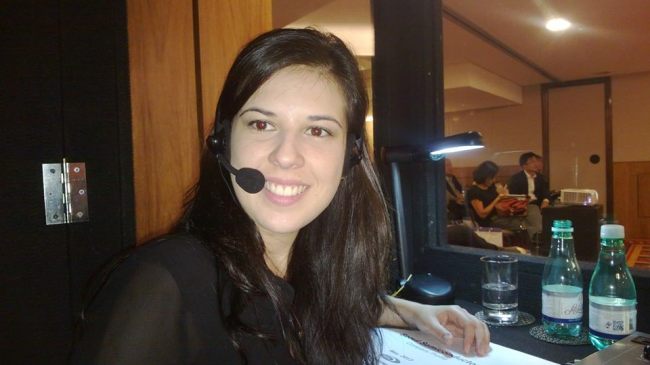Hello, dear readers! Hope you’ve had a great Labour Day holiday last week. As for me, I’m on my countdown for my two-week vacation and for welcoming two dear Polish friends who are visiting me next week. While they don’t arrive, let’s welcome today’s guest here on our blog, Marina Caproni, who will talk about simultaneous interpreting – our first guest post on interpreting.
Welcome, Marina!
Simultaneous Interpreting: Leaving the Comfort Zone
My path in interpreting is a little controversial, since I am graduated as a translator, but not as an interpreter and also, because this world kind of dragged me in unexpectedly. I never tried to get into the interpreting world, but when I did I loved it. So, it happened like this:
The phone rang:
— Hello, Marina. I have your résumé in my hands and I see you are an interpreter.
I was a little confused because I had just woken up and I said:
— No, I’m not. Sorry.
And he said:
— Really? It’s in your résumé!
— In my résumé? — I said. — This is Marina Caproni. Are you sure this is my résumé?
And he said:
— Yes, I am. It says here that you worked in a company as a translator and interpreter for one year.
That was the first time someone has focused on the interpreter part of my résumé. I worked for one year in a project with people from different nationalities and sometimes I had to do some consecutive interpreting at the office. But when I was still confused about this new title he had just assigned to me, he said:
— Hey! Why don’t you come to the office and try it? It will be a short test and we will see if you fit the job. We are five minutes away from your place.
I said yes but started to get nervous thinking: “I can’t do this. It will be a shame. I’m not an actual interpreter.”
I thought about not going, but in the end I said:
— Ok, I’ll go.
In the worst scenario, it would be an opportunity of increasing my translation network.
I met the man on the phone and started the test, interpreting a Steve Job’ speech on the iOS. After 40 seconds interpreting the video I got a new job.
I had a proper training before starting to work, of course, but just one week later there I was, working on an UNO’s conference in Brazil. It was awesome. I was so excited, so happy, feeling like I had just found a brand new world. From that moment on, I was a simultaneous interpreter.
However, the job is not easy. It demands full concentration. You have to work inside a cabin with a partner. You talk for 20 minutes and then pass the stick to your partner. Forget it if you don’t know how to work as a team because you cannot work alone. It demands such a concentration that in 20 minutes you are already exhausted.
One important thing: you have to be humble and know that only in a partnership the job is well done. The ego has to be left outside the cabin because the work is ruined when you think you’re better than your partner. And trust me, it happens a lot.
But the most important thing is to always be ready. The preparation is the hardest work – working on glossaries on the subject and reading everything you can find about it, practicing with videos on the theme, collecting any material you can get from the client about the subject at issue, working on your voice tone, talking to the speaker before the speech to clear up any doubts and solve any possible problems.
One day you will be interpreter in a conference on the Korean culture, with people talking about the beauties and advances of that country, but on the other day you will work in a conference on a 3D mesh for hernia surgeries, including an interpretation of two live surgeries.
You can start with a proper course. There are 2-year graduate degrees on interpretation if you’re already an undergraduate, or you can go to a translation and interpretation school, if you are not. I started studying by myself, reading a lot of books, articles, videos on the theme, and learning by doing it. I had been working as a translator for more than six years and one day I realized I had a huge vocabulary, which is vital for the job since you have to think fast and not being stuck on a term you can’t remember the translation.
No matter which path you choose, it will be hard work, but it is also very fun. You will know people from all over the world with different accents, cultures, lifestyles and, in the end of the day, you will feel complete as a professional.
It is a crazy world, where you have to be a fast thinker, very focused, and know how to work under pressure, but it is also a nice opportunity to leave your comfort zone behind your computer and face the world outside.
As always, it’s lovely to hear how different colleagues have started out as translators and/or interpreters. Thanks a lot for your kind contribution, Marina! Your life seems quite interesting as an interpreter.
Please, do comment!
Marina is graduated at UNESP as a translator. She works in the area since 2006 and as an interpreter since 2012. Most of her work is related to technical areas such as law, aeronautics, and human rights.


Very interesting life! Very nice to hear our colleagues’ experiences that way!!! Keep up the good work, Marina and Carol!!!
LikeLike
Thanks, Fernanda!
I’m glad you’re enjoying the series! 🙂
LikeLike
Thanks, Fernanda!
LikeLike
Great, Marina! Sometimes we are “picked” by our jobs, and not the opposite! Nice to know your story!
LikeLike
Thanks, Patricia! And I hope we can be partners in the cabin again!
LikeLike
It’s funny how life surprises us and shows us different ways we planned.
Congratulations and very successful career Marina, you deserve!
LikeLike
You’re right, Jhonathan. Thank you!
LikeLike
Hi, Marina. I didn’t know you had followed that path. I still don’t feel capable of working as an interpreter, but I very much admire those who do it. Congrats!
LikeLike
I didn’t think I was capable too, but then one day I heard I was able from someone that have been working in the area for many years. Sometimes we underestimate ourselves. Thanks, Reginaldo!
LikeLike
I totally agree with you on the “underestimate” part, Marina!
We are probably too hard on ourselves and never see our true potential. Luckily, there are other people who reveal that part of ours to us. 🙂
LikeLike
You might be right. One day maybe I’ll try it. 🙂
LikeLike